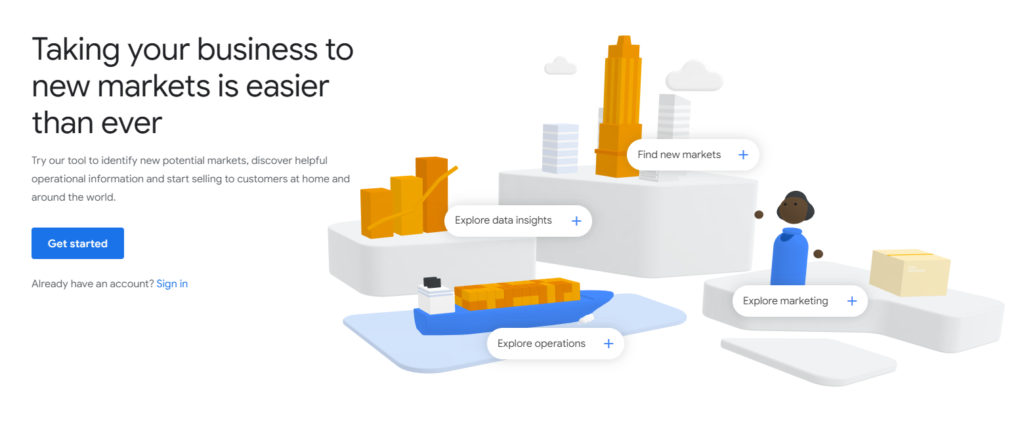After you become an established player in your local market, it may be time to expand your business internationally.
There is a lot of information floating around the internet about selling internationally. Mostly, it is about how you can translate your shop with a plugin and start advertising.
But this is an oversimplified way of doing things that relies on luck and can do more harm than good. And if it doesn’t work, you might be discouraged and stop trying.
If you want to maximize your chances of success, you should do some research, set up small tests, and expect some level of failure.
Research the market’s potential
To find out which market to go to, you must look at where your customers are coming from. And the best data you have is in your GA4 account (or other analytics tool you might use).
The number of visitors might indicate interest in your products. But also, look at how they are navigating your website. What pages are they viewing the most, and how do the number of pages visited, bounce rate, and session duration compare to your local visitors.
After you analyze your data, you can move to external data sources to strengthen your research.
Google Market Finder
Google has a little-known tool called the Market Finder. Even though this won’t give you a great level of detail, the questionnaire will give you an idea of how ready you are to expand your business.

The Market Finder’s suggestions are based on your products’ demand, popular market trends, disposable income per capita, internet users, and the recommended bid.
Google Keyword Planner
To have a more accurate picture of the target market, you might want to use other tools to determine the potential traffic. The easiest way to do this is with Google’s Keyword Planner.
You can start looking at the search volumes, trends, and CPC ranges to determine the demand.
SEO tools
Another way of determining the search volumes is to use tools traditionally used in SEO, such as Ahrefs of Semrush. Even though using them in your research is not a must, they can give you information about who is ranking high for the keywords you are targeting.
This provides you with valuable information about your competitors and will give you an idea of how difficult it would be to expand your business in that target market.
Research your competitors
Sometimes, you might be lucky enough to see that your competitors already did the heavy lifting. All you have to do is know what to look for and see how you can adapt your strategy based on the actions they took.
Shipping policies
A good starting point is to look at your competitors’ shipping policies. This will tell you where they are shipping orders, how long it takes, and how much it costs.
This is where you need to think about your advantages and disadvantages. Can you do better than them? If yes, you’re good to go. If not, you’ll have to think of other ways to stand out and provide value to your customers.
Language selectors
Check whether they have a language selector on their website. If they have gone through the effort of translating their content, it might be a good indicator that the target market makes good business sense.
An overlooked aspect by many businesses is the positioning. See if your competitors did the bare minimum and just translated the website, or if you can spot subtle differences between the languages.
If the content is a literal translation, you have a great opportunity, as you can tailor the messaging and positioning of your business. If they use different unique selling points or different messaging, take notes. This will help you later on.
Look at your competitors’ ads
Make sure to use Google’s Ad Transparency Center. See what type of ads are they running, what ad assets are they using, and how they deliver the message.
Check if they are creating high quality ads and follow the best practices. If they aren’t you can easily create ads to outperform theirs.
Set up a small scale test
When you’re ready to expand your business, set up a small scale test. This can be anything that you can implement fast, easy, and cheap.
You do have to keep in mind that you should set a budget upfront which you are comfortable losing. After all, this is a gamble made on an educated guess.
Depending on how you currently run your business, there are multiple options to set up the test. I’ll cover three options, but you must check what makes more sense for your case.
International parcels
If you can ship internationally, even at a small loss or break-even point, do it. From a logistics point of view, this is the simplest way of checking whether the customers are interested in your products.
And it doesn’t really matter how you implement this. You can modify your shipping settings to accept orders from the target market. Or you can just add a little statement below the ‘Add to cart’ button stating ‘For orders from {country_name} contact support’. But keep in mind that adding extra steps to the checkout process will affect your conversion rate.
Leverage marketplaces
Another option would be to send a small batch of products to a marketplace that also handles fulfillment. For example, you can send some inventory to an Amazon warehouse and set up a small FBA operation.
This way, you can set up your test without worrying about the logistics. But keep your product prices the same even if Amazon’s fees are eating up your margins. Remember, you want to test the market, not make a profit.
If you want to leverage marketplaces and you can fulfill the orders yourself, that is even better. Just be aware that pushing your product data to the marketplace may come with some extra work. But you can use a product feed management tool to easily handle that.
Leverage third party logistics (3PL)
If you don’t want to sell through a marketplace, but still want the benefit of outsourced fulfillment, consider 3PLs.
This allows you to go with the option of modifying your store shipping locations and not adding extra steps to the checkout process.
However, try to look for 3PLs that have an integration to the ecommerce platform you are using. Through a plugin, you can have an easier time syncing your orders because the whole process is automated.
Remember translation ≠ localization
When testing a new market you must do your best to maximize your chances of success. A half-assed experiment will only give you the impression the idea is bad.
I’ve seen cases in which people have an incredible drive to expand their business, translate a shop’s content, start advertising, don’t see positive results, and give up in frustration. Even though the market made sense to expand to. But never looked to see if they could improve the experiment setup.
This is where networking plays a big role. If you don’t have connections in the target market, make some. If you do, leverage them.
You can always ask for help with the experiment design. See what the cultural norms are, what payment processors and parcel carriers they prefer, and how you can provide a better shopping experience than your competitors.
You will be able to learn much faster from someone else’s experience than by testing things yourself. This also reduces your risk of failure.



